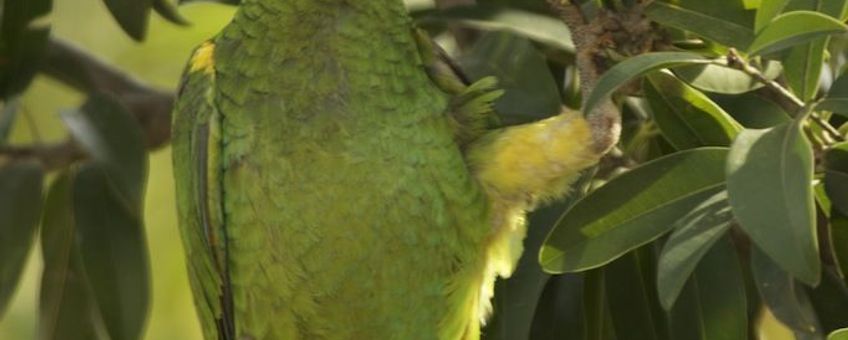
Geelvleugelamazone: geliefd en gevreesd op Bonaire
Bericht uitgegeven door Dutch Caribbean Nature Alliance (DCNA) [land] op [publicatiedatum]
Op Bonaire huist één van de twee overlevende inheemse populaties van de Geelvleugelamazone (Amazona barbadensis), een papegaai die op het eiland zelf bekend staat als ‘Lora’. Terwijl de Geelvleugelamazone wereldwijd in aantal afneemt, gaat het dankzij de inzet van natuurbeschermingsorganisaties en het lokale bestuur goed met de populatie op Bonaire. Niet iedereen is hier echter blij mee. Door het kappen van bomen, huizenbouw en begrazing kunnen deze fruitetende vogels niet meer genoeg voedsel in het wild vinden, en zoeken ze steeds vaker hun heil bij fruitbomen in tuinen en op het boerenland. Echo, de papegaaienbeschermingsorganisatie van Bonaire, probeert nu meer inzicht te krijgen in de beschikbaarheid van voedselbronnen voor de Geelvleugelamazones door het jaar heen. Daarnaast gaat ze onderzoeken hoe en wanneer de dieren zich over het eiland verspreiden. Met deze informatie gaat de organisatie proberen het platteland weer geschikter te maken voor de papegaaien en zo het conflict tussen mens en papegaai op te lossen.
Lees verder in het Engels......

Outside of Venezuela, Bonaire is home to the only surviving native population of Yellow-shouldered Amazon Parrots (Amazona barbadensis), locally known as the Lora. While global numbers of the parrot are declining, locally the parrot population is showing signs of recovery thanks to the combined efforts of conservation organisations and the local government. While conservationists enjoy seeing more parrots on the island, not everyone finds this as a good thing. Limited food supply in the wild causes increasing numbers of parrots to feed on fruit trees in gardens and ‘kunukus’ (little countryside farmlands). The resulting conflict has the potential to undermine conservation efforts. Bonaire’s situation is by no means unique; conflict between parrots and people is an issue throughout the Caribbean.
Habitat loss and degradation is the underlying cause of parrot/human conflict. Where there used to be fruit trees, there are now houses. Historic tree felling has caused the loss of species that served as the parrot’s staple food resource, including Lignum Vitae (Guaiacum officinale), West Indian Satinwood (Zanthoxylum flavum) and Hog Plum (Spondias mombin), even from the rural parts of the island. This loss has been compounded by large-scale grazing by feral goats and donkeys, and more recently feral pigs. A historic lack of grazing herbivores on Bonaire means trees have not evolved the required defences to allow them to withstand or recover from grazing pressure. Seedlings are not able to mature to fruit-bearing trees, resulting in low food availability for the parrots in rural areas all across the island.
Echo, Bonaire’s parrot conservation organisation, is studying the pressures experienced by breeding and non-breeding adult parrots on Bonaire. For conservation to be effective, it is imperative to know exactly what is happening within the population, otherwise high adult survival might mask poor juvenile recruitment, or vice versa. This is especially the case with long-lived species like the Lora. Lora lifespan in the wild is not known, but estimates are between 40 and 60 years old. Understanding population dynamics over this time period forms a key part of Echo’s research. With a good understanding of pre-fledging survival through previous research, Echo is now focused on post-fledging and adult survival.

In addition to understanding population dynamics, Echo is monitoring the use of rural and urban habitat by the Lora. Observations indicate that parrots prefer to feed in rural areas, but in case of low food availability they are forced to migrate into urban areas. Furthermore, given that the urban-foraging parrots hang around the urban areas most of the day, the Echo team suspect that those individuals are largely non-breeding parrots. Breeding parrots show more active behaviour flying up and down to their nests to feed their chicks.
With research-driven conservation and outreach, Echo will ensure that Bonaire’s Yellow-shouldered Amazon Parrot population can continue to increase. Future projects will see the development of ‘parrot tours’ with local residents, enabling the inhabitants of Bonaire to realise the economic value of their parrot, as well as the development of Echo’s Dos Pos Conservation Centre, to allow residents and visitors alike to experience Lora encounters in Bonaire’s unique nature.
Read the entire article in Bionews-august-2013.
Text: Michaela Roberts, Echo
Photos: Sam Williams, Echo
Published by: Dutch Caribbean Nature Alliance (DCNA)
Nederlandse inleiding: Sara Mulder, De Natuurkalender
